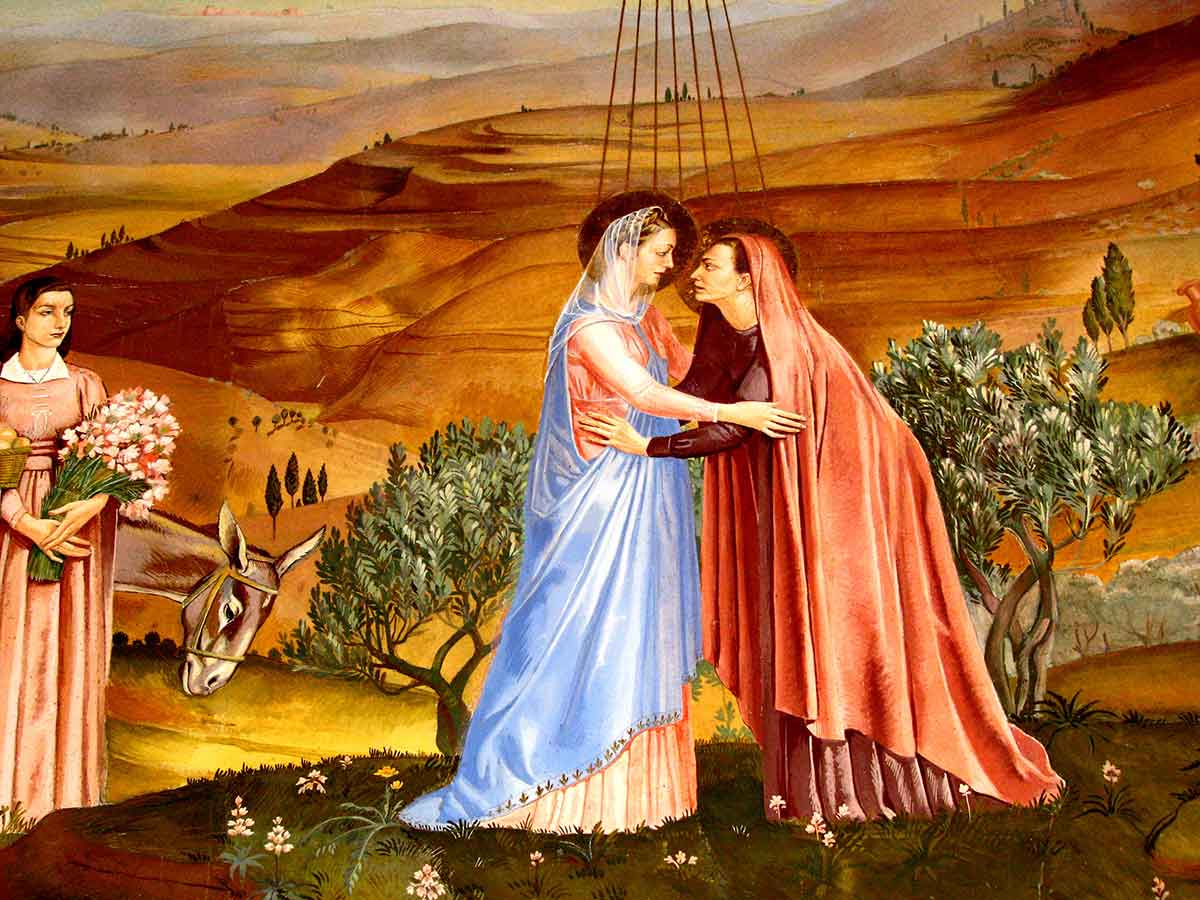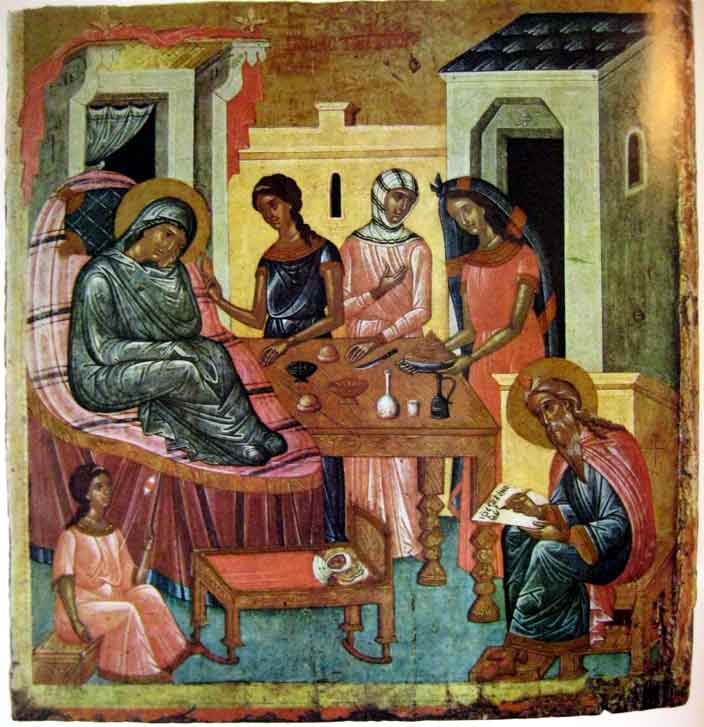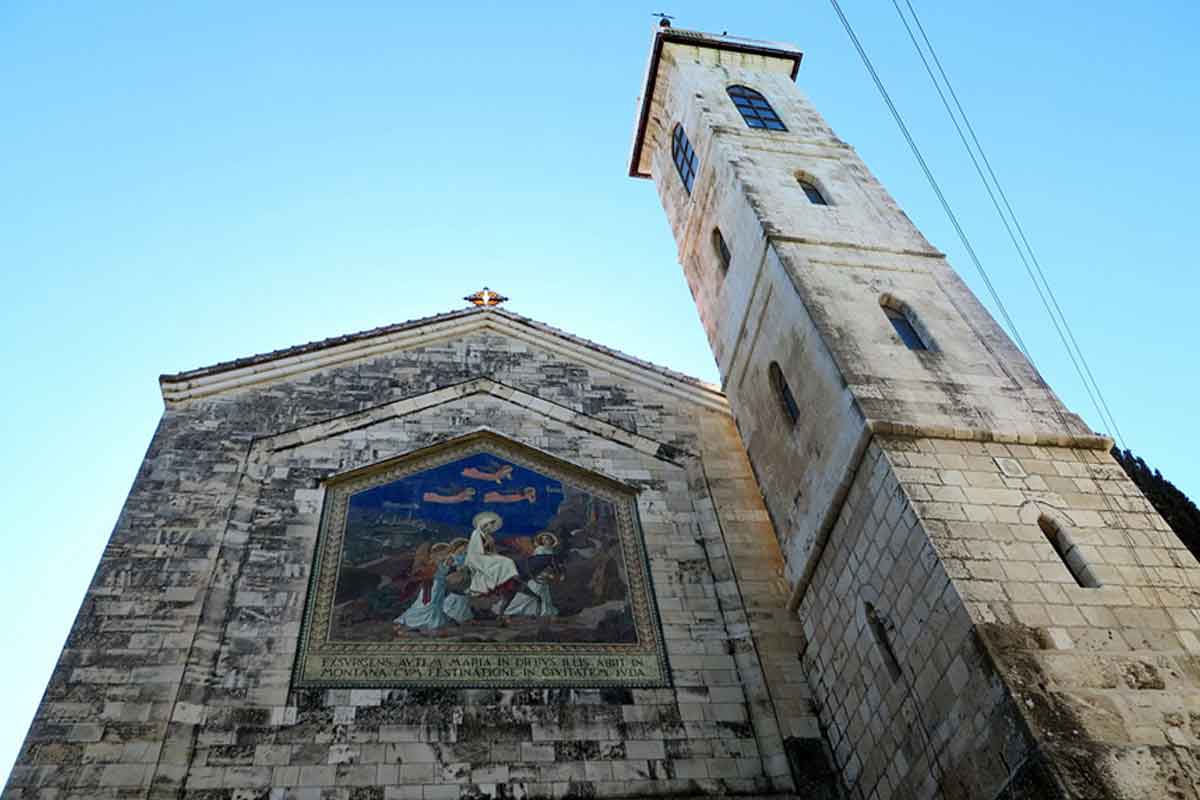St Elizabeth, Cousin of Mary

St Elizabeth welcomes the Blessed Virgin Mary, in the Church of the Visitation in Ein Kerem, Jerusalem
St Elizabeth at a Glance
Born: 1st century BC, probably in Judea
Died: 1st century AD, probably in Judea
Feast: November 5
Patronages: Pregnant women
She is the saint who gave us the second verse of the Hail Mary: “Blessed art thou amongst women, and blessed is the fruit of thy womb, Jesus.” St Elizabeth expressed these sentiments when the newly-pregnant Mary visited her in the Judean hill country.
Tradition places that encounter in Ein Kerem, a village near Jerusalem. Today two Catholic churches there remember St Elizabeth. One is the church of the Visitation on top of a hill, where Elizabeth’s encounter with her cousin Mary, and Mary’s “Magnificat”, are remembered. The other church marks St Elizabeth’s other great contribution to the Gospel: the birth of John the Baptist who would prepare the way for the Lord.
We do not know exactly when or where Elizabeth was born. Since she was said to have been significantly older than Mary — according to Luke she was past the normal child-bearing age when she was pregnant with John — one may time her birth to 40-50 BC.
Tradition places Mary’s birth in Jerusalem, so it is likely that her relatives also hailed from the Holy City or surrounds. This may include Elizabeth.
Elizabeth came from a family in the priestly line of Aaron. Elizabeth was married to Zechariah, who was a priest, also in the line of Aaron. The couple was apparently well-off, maintaining two residences, one in the village and the other on top of a hill, near a spring. According to St Luke, they conducted their lives with virtue and fidelity to the Commandments. Their great sorrow, and public embarrassment, was not having been able to conceive a child.
The couple’s story enters the Gospel when they were at what Luke calls an “advanced age”, which in a time of low life-expectancy meant something different to our modern understanding.
One day Zechariah went off to Jerusalem to do his priestly duty in the Temple. That week, his task was to perform the incense offering. As he was doing his job at the altar, an angel of the Lord appeared to him, conveying startling news: Zechariah and Elizabeth would have a son. Regardless of the parents’ preferences, the boy would be called John — and he would be the forerunner of the Messiah.
Quite reasonably, Zechariah was dubious about all of this and asked for a sign that might prove the prophecy. The angel then introduced himself as Gabriel, declared himself to be on a mission of God — and since Zechariah was doubting him and wanted a sign, he would be struck dumb until the birth of the child.
After this extraordinary encounter, Zechariah went to the outer court of the temple to impart the customary blessing to the waiting faithful. But he couldn’t speak.

15th-century depiction of St John’s Nativity, with Zechariah writing the child’s name.
Unexpected pregnancy
After the speechless Zechariah returned home, Elizabeth duly conceived, as promised by the angel. “The Lord has done this for me, now that it has pleased him to take away the humiliation I suffered in public,” Elizabeth said, noting a prevailing prejudice against childless women.
She moved into the hilltop residence where she spent the next five months in seclusion. Elizabeth was five months pregnant when her young cousin Mary from Nazareth arrived at the residence. Having been told by the angel Gabriel that Elizabeth was pregnant, the teenage girl had made the long and hazardous journey from Nazareth in Galilee to the Judean hill country. She would remain there for three months, returning home before her own pregnancy would make travelling too difficult.
Mary’s visit was a joyous surprise. Somehow Elizabeth knew about the nature of Mary’s pregnancy — and so did the child she was carrying, for it leapt for joy in her womb. She greeted the girl with the words: “Of all women you are the most blessed, and blessed is the fruit of your womb. Why should I be honoured with a visit from the mother of my Lord? Look, the moment your greeting reached my ears, the child in my womb leapt for joy. Yes, blessed is she who believed that the promise made her by the Lord would be fulfilled” (Luke 1:42-45). Whereupon Mary responded with what we now call the “Magnificat”.

The church of the Visitation, in Ein Kerem, where the Blessed Virgin visited her cousin St Elizabeth. (Photo: Günther Simmermacher)
Having returned from the hilltop residence to the family home in the village — where everybody was delighted for her — Elizabeth gave birth to her miracle baby. A grotto in today’s church of the Nativity of St John in Ein Kerem marks the spot of that birth.
The baby’s circumcision, on the eighth day after birth, was attended by neighbours, friends and relatives. It was taken for granted by all present that the boy would be named after his still speechless father, but Elizabeth confounded the guests when she insisted that the child would be named John.
Not quite believing what they were hearing from the mother, the people confronted the father. Zechariah wrote his response: “His name is John.” At that, Zechariah’s powers of speech returned, as promised by the angel, and he exclaimed a blessing.
Addressing his son, Zechariah said: “And you, little child, you shall be called Prophet of the Most High, for you will go before the Lord to prepare a way for him, to give his people knowledge of salvation through the forgiveness of their sins, because of the faithful love of our God in which the rising sun has come from on high to visit us, to give light to those who live in darkness and the shadow dark as death, and to guide our feet into the way of peace.” As John the Baptist, the child grew up to do just that.
But first there was jeopardy, at least according to tradition. By now Elizabeth and Zechariah have departed Luke’s Gospel. But the apocryphal Gospel of James from the 2nd-century extends King Herod’s genocidal search for the infant King of the Jews to their family.
While Elizabeth was hiding with John in the hilltop residence — the rolling stone which reputedly sealed their hideaway can still be seen in the church of the Visitation — Zechariah was questioned by Herod’s soldiers about the whereabouts of his son, who was under two years old and therefore liable to be massacred. The father refused to betray his son and wife, and was murdered.
Matthew 23:35 offers a different theory. He reports Jesus as referring to a Zechariah who was “murdered between the sanctuary and the altar”. The Church Father Origen suggested that Zechariah was John’s father. This would mean that Zechariah was killed by the religious establishment.
As for Elizabeth, the trail on the remainder of her life goes cold after John’s circumcision.
Though not named in the Qu’ran, Elizabeth is also venerated in Islam as a wise and pious woman. Islam also honours Zechariah (or Zakaria) and John (or Yahya).
The Catholic Church marks the feast of Ss Elizabeth and Zechariah on November 5.
Published in the November 2022 issue of The Southern Cross magazine
- St Luke Prayer - October 15, 2025
- The Concept and Tasks of Papal Diplomacy - October 14, 2025
- Are Bishops and Priests the Successors of the Apostles? - October 14, 2025





